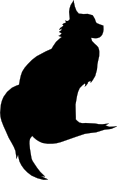

2025-06-14 16:05:00
I've been into drawing and zine making for quite a while now. When I did a small talk on zine making last year, I dove into reproduction techniques: laser printer, xerox, mimeograph, stenciling and risography. I decided then that I really want to try working with a Riso printer at least once.
Under the guidance of Justyna and Angi, the eight of us got an explanation on how the Riso printers work, we did a quick group project to trial the machine and then we were invited to work on our own projects. I'd come prepared and brought the cover of "The tale of the dubious crypto", which I'd tried to make ready for risography.
For today's workshop we got to choose between neon pink + red, or neon orange +teal. I chose the latter, doubting myself all the way. The choice didn't come out great, mostly because of the project I'd chosen and on how I'd prepared it. As Marli put it: "Is it okay to say that I hate it?". :D She's not wrong: the end result looks kinda garish. :D
But I did learn quite a few things!
Justyna and Angi told me how they use "clipping mask layers" in Illustrator, Photoshop and Procreat to easily try different colors and effects. It's demonstrated in the Risopop starter workshop booklet. Inkscape does things differently, there's no nice and easy trick with layers for this.
Thanks to Sweater Cat Designs I am learning how to do it with Inkscape though. And that's where today's big lesson comes in: my grayscale files were created by making my objects black and then messing with their opacity. Shouldn'ta done that... I should've worked with grayscale, white to black.
On to my next project, which hopefully will turn out better! If I want the gradients to turn out nicer than they did and if I want a decently easy workflow, I'm afraid I'll have to start learning a new tool instead of Inkscape.
kilala.nl tags: creative,
View or add comments (curr. 1)
All content, with exception of "borrowed" blogpost images, or unless otherwise indicated, is copyright of Tess Sluijter. The character Kilala the cat-demon is copyright of Rumiko Takahashi and used here without permission.
2025-06-14 16:49:00
Posted by Tess
I'm quickly coming to the realization that I need to switch tools.
The workflow with Inkscape is so very different from what one'd hope to have if they want to get even close to the work Sinniar shows in their Reddit thread.
In short, many tools have "clipping mask layers" that you can use to draw in greyscale and see the results show up in the desired color. Inscape does NOT have that; it works almost literally inside out, where I'd have to use my drawing as the inverse mask over an object of the desired color. But you can't keep on drawing and editing while seeing the live changes.